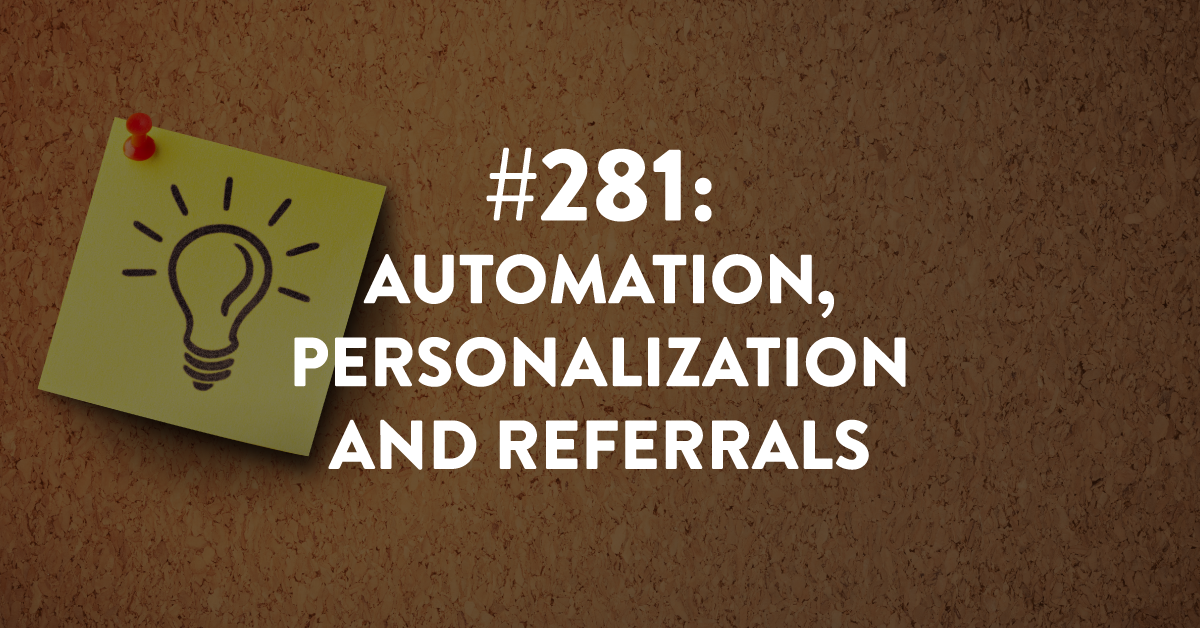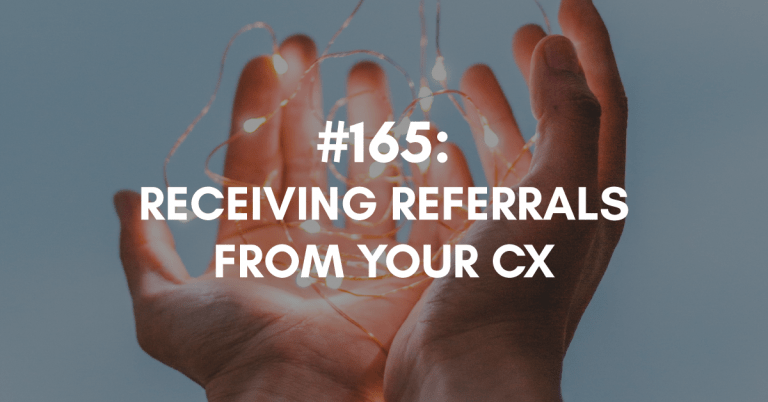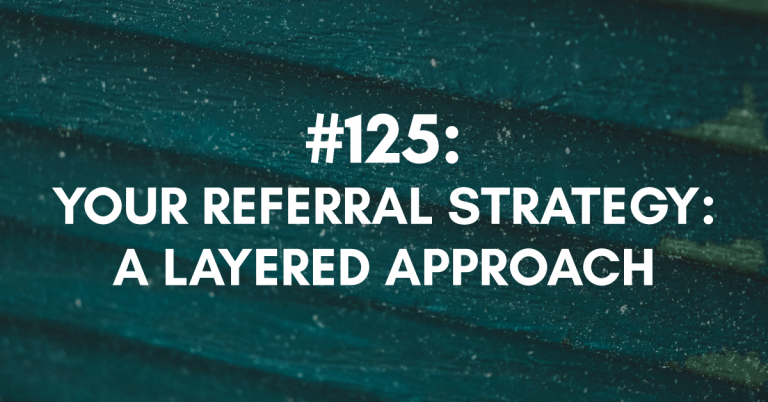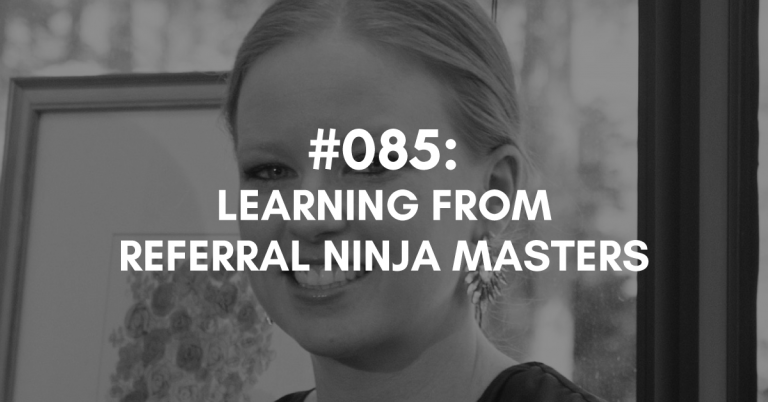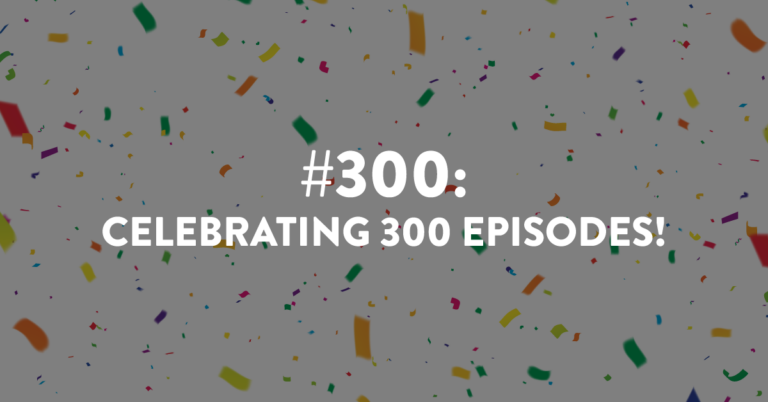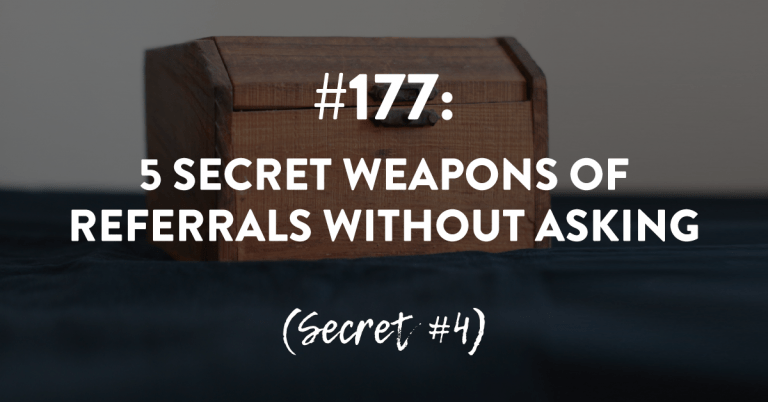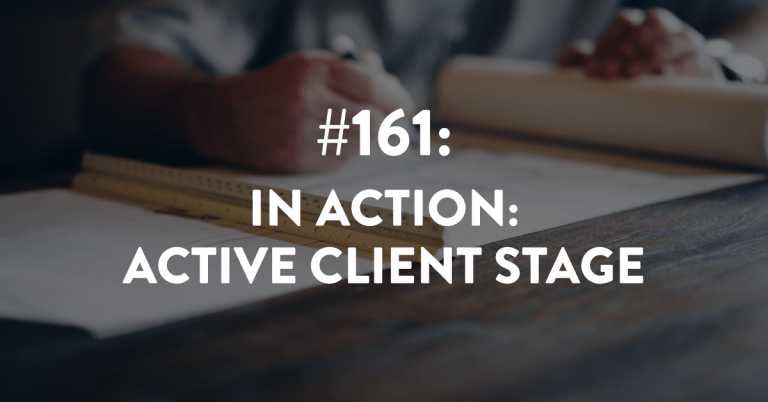Ep #281: Automation, Personalization and Referrals
Personalization vs. Automation: which is the key to successful referrals? Spoiler alert — it’s not a versus thing at all. It’s about finding the perfect balance between the two.
In this episode, I’ll explain the importance of blending personalization and automation in the right balance to effectively cultivate referrals. When building your outreach to existing referral sources, striking the right balance between personalization and automation is crucial.
We teach a proprietary framework that focuses on this balance to ensure you’re not spending too much time on personalization or becoming robotic with too little. It’s all about finding that sweet spot!
Links Mentioned During the Episode:
Download the template I give my clients to correctly identify your existing referral sources, the people who are referring you. It’s free and easy to use.
Apply now to join our Building a Referable Business™ coaching program.
Next Episode:
Next episode is #282, and we’re gonna talk about something very specific as it relates to having a referable client experience.
Download The Full Episode Transcript
Read the Transcript Below:
Stacey Brown Randall: There is this constant debate, personalization versus automation when it comes to referrals. But it’s not a versus at all. Let me explain.
Hey there, and welcome to episode 281 of the Roadmap to Referrals podcast, a show about helping you build a referable business. I’m your host, Stacey Brown-Randall. My journey from a business failure to a successful business now 10 years in, I know generating referrals naturally and consistently has made all the difference. Working with clients around the world, we leverage the science of referrals, protect relationships above all else, and help you build a referable business.
There’s this piece that I think people overlook when they are diving into the world of referrals.
And whether they’re diving into it new for the very first time, or they’ve always kind of known about referrals, but now they’re going to kind of get back into focusing on referrals.
And I see it specifically in the process that I teach, which is actually a balance of automation and personalization, because you need both, which I know can be surprising to folks.
So when people are like, OK, let’s do referrals, it’s true. It’s like, OK, automate, personalize. The pendulum will swing vastly one side to the other.
And I’ll hear people say, when they are doing like over personalization, “I gotta do individual outreach to all 20 of my referral sources every single month, specifically to them personally.” Or on the flip side, I’ll hear people say, go all in on automation. And they’ll be like, “Can I accomplish this with an email campaign or mailing monthly postcards?”
My friends, both are wrong.
Should you personalize? Yes. Should you automate? Yes. The trick is understanding how to blend them.
When? How much? How often? And the balance may not be 50/50, but you can leverage both, personalization and automation for referral success.
Let’s look at automation. Too much automation is going to lack engagement. But too little automation will lack efficiency.
So think about it this way, as an example. An automated email campaign, which some people call a drip campaign or dripping emails, right? When you send emails out automatically through a system that sends it for you, and some type of like rhythm or routine.
It cannot provide real connection. It cannot build or strengthen a relationship. In fact, it quickly becomes just more noise in your referral source’s inbox. So when you have too much automation, it really lacks engagement.
It’s the same thing with like trying to think that you can send text messages to your referral source on some kind of like every 60-day calendar routine, right? It’s like, no, no, no.
So when there’s too much automation thinking you can solve this with some kind of like automated email campaign or some text messaging campaign every 60 days, it’s going to lack connection, relationship building, engagement.
Now on the other side of that, let’s talk about personalization. Too much personalization, let’s be honest, that is a time suck. But too little means you become robotic.
So can you imagine, just as a crazy example, can you imagine what your calendar would look like if you had to do coffee with every single one of your referral sources every month? Or heck, even every other month? Oh heavens, no. Not gonna happen. No business owner has that kind of time.
There’s a balance. There’s an infusion of both automation and personalization. That is the key.
And you have to understand that, and you can’t overlook it. Because when you’re lacking either automation or personalization, you’re sitting at one end of the continuum that is not getting the job done, that is not going to be able to cultivate more referrals coming from your referral sources.
So when I teach the four parts of our proprietary framework on how to build your outreach to your existing referral sources, we focus on the right balance. And the other thing is we define personalization and automation a little bit different than you would think. So let me explain what I mean.
Hey there, pardon the interruption. Let’s change your business for 2024 together. No need for you to go it alone. You deserve to double, triple, or even quadruple your referrals. And I have the roadmap to show you exactly how to do it. I want you to join me inside my coaching program, Building a Referable Business. Find out all the details of the coaching program plus the link to complete your application at StaceyBrownRandall.com/referable. That’s StaceyBrownRandall.com/referable. And Stacey has an E. Now back to the episode.
Okay, so with the four parts of our proprietary framework on how to build outreach to your existing referral sources, the first key you have to nail is understanding balance. But hang on one second, because I want to quickly explain what I mean when I say existing referral sources. Because if you don’t have that point, everything else I’m about to say will make zero sense.
So if you’ve been here a while, if you’ve been hanging out for a while, you know this definition. And maybe you actually can say it out loud along with me. That would be pretty cool. I mean, I won’t be able to hear you, but I’ll know you’re doing it. And that’ll make me smile.
So you probably know this definition of an existing referral source. But if you’re new around here, you may be like, wait, What’s the difference? It’s just a referral source. No, no, no, my friend.
An existing referral source is someone who has actually referred you before.
Now, it may have been four years ago, or it could have been four days ago. But this is somebody who has actually referred a potential client to you. Does not mean that potential client or prospect became a client, it means that they referred someone to you. Doesn’t necessarily mean that person pulled the trigger and ended up hiring you.
So when I say existing referral sources, I’m talking about the people that have referred potential clients to you. Not somebody you want to do it. This is somebody who has done it. So let’s make sure we’re all on the same page here.
Because what I’m talking about is the outreach that we do to our existing referral sources. I’m not talking about people you want to refer you. That is a different process.
So what you have to understand when you’re thinking about who your existing referral sources are and the way we teach it within our framework, this four-part framework, and it’s really based on how do we build the outreach to them so that we can actually cultivate, use the right language, strengthen and deepen the relationship, and ultimately, get more referrals.
So that balance, balance being the key between automation and personalization. And that balance is actually based on who your referral sources are, the commonalities, whether they’re in town, local, or not. And also, it’s going to be a balance based on your capacity, what is authentic to you, and yes, also your budget. All of that matters when we’re creating your outreach to your existing referral sources.
Because here’s the thing, I am a huge proponent that we have to make it manageable for ourselves as business owners while also making sure it stinking works. Because if it doesn’t work, it doesn’t matter. And if it doesn’t work for us, well, we won’t do it anyways. So then again, it doesn’t matter.
So when we think about this framework that we use, when we’re showing people, okay, here’s what it’s going to look like to build out your outreach to the people who have referred you before, your existing referral sources. We’re going to use a balance of personalization and automation. But that balance is going to be based on who your referral sources are.
So the majority of my referral sources, people who refer clients to me, whether that’s to my Building a Referable Business coaching program or just to one of my online programs. And sometimes the referral starts with them just referring them my book, right?
So the idea here is none of these people are local to me. I mean, some of them are, yes. My Charlotte peeps that refer me, I love you. But most of the people who are going to refer potential clients to me, they’re actually all around the world.
I have a number of clients in Australia because I have a referral source in Australia. And I’m located in Charlotte, North Carolina. Probably never going to meet her in person, which would be amazing. And if it happens, that would be killer. But the truth is it’s probably not going to happen.
So how I would build outreach to my referral source that’s sitting all the way in Australia would look different than how maybe you’re going to build outreach to a referral source who is literally a mile away from you, right? Same with me. But you don’t just have one referral source, typically, not what we’re talking about, right?
So we have to take into account, are your referral sources local or are they not? What do they have in common? And most people are like, well, I mean, they’re all different. So what would they have in common? You’ll never know what they have in common until you actually know who your referral sources are.
I’m going to walk you through that at the very end. But right now, I want to stick to this idea of really looking at the balance and the blend of automation and personalization. And again, guys, it has got to be manageable for you.
So it’s not just who these people are, what their commonalities are, whether they’re local or not local, but also, like I said, your capacity, what’s authentic to you and your budget.
And so when we’re thinking through all this, all right, let’s talk about this from a personalization perspective. So again, balance being the key of understanding who these referral sources are, and then defining personalization and automation a little bit differently.
So let’s look at it with personalization. So we are gonna focus the same outreach to all of our referral sources. When we are doing outreach or what we call internally with my clients, a touchpoint. When we are doing a touchpoint to our referral sources, we are actually going to do the same touchpoint to all of our referral sources.
But here’s the catch, and this is where personalization matters. Because if we’re doing the same thing to everybody, it doesn’t feel very personalized, right? But ha-ha, nope, hang on, because the way we do it, it is. And that’s because the ‘what’ we do for that outreach, for that touchpoint, feels personalized to the person receiving it, to your referral source when they receive that outreach.
That is how we handle personalization. Which means what you do, that actual outreach, and the messaging of what you say, and how you plant referral seeds, is key. And it’s also making sure we use a blend of surprise and delight, plus variety, and a few other things from behavioral economics that really make this stuff work.
So even in our definition of personalization, there is a little bit of like, quote unquote, automation, because we’re doing the same thing for everybody, but we’re not sending everybody the same postcard.
Like, oh my gosh, no, you would not be allowed to do that if you’re working with me. What we’re doing when it’s our outreach to our referral sources, to show them care, to tell them that we appreciate them, we don’t take them for granted for referring people to us, it’s going to feel very personalized when they receive it.
Because what we do is pretty unique and special. And it doesn’t actually cost hardly any money most of the time, if you don’t want it to. And so from there, that is still personalization.
And now let’s look at automation. Because with automation, what I always tell my clients is you don’t have to touch every single outreach or touch point that you do. You can use delegation to someone on your team. You can use outsourcing to maybe like a virtual assistant or another company that can handle part of this for you.
And you have to make sure you get this part right, but you can automate that piece happening. I don’t mean you push a button, and it magically appears, right? I’m talking about the idea that there are things you can do to automate the process within individual or specific touch points.
And here’s the other thing that people always get confused on. Not every single note that you send has to be handwritten. No, hang on. Wait, you need to hear my clarifying disclaimer before you run off thinking that you don’t have to handwrite your thank you notes.
You do. When someone refers you, you will always handwrite a thank you note. That is a non-negotiable.
And in fact, I was actually just explaining to one of my Building a Referable Business, my BRB coaching members, the three times you must handwrite. And then the other times, you don’t have to. You can actually print the messages, and you don’t actually have to handwrite them all.
So as you can imagine, one of those three times, my friends, is when someone refers you, you better take the time to handwrite them a thank you note.
And so when we look at personalization and automation, we like both and we use both because both are valuable. The automation piece is going to be valuable because it allows us to make sure it gets done, and it isn’t completely reliant on us to do it. The personalization matters because if it’s not personalized, it’s just more noise, or it’s not noticed, or it’s not recognized, or it doesn’t have the impact on our referral source the way we want it to.
So you need both.
So if you are diving into the world of referrals, whether you’re getting back to it or this is the first time for you, you need to keep in mind the necessity of balancing both automation and personalization. You need both, and you need to use them correctly and in the right way.
And of course, if you need help figuring that piece out and getting it all right, let me know. Just shoot me a direct message, a DM on LinkedIn or Instagram. You can find me at Stacey Brown Randall, pretty much everywhere. Or you know what? You can also just shoot me an email. I would love to hear from you.
So I will post the resources mentioned in this episode on our show notes page for this episode, which is StaceyBrownRandall.com/281.
Because there’s one more thing I want to tell you about. If you don’t know who your existing referral sources are, I want to give you the template that I give my clients. So you can easily go through the process of identifying, okay, so who are the people who are referring me or have referred me?
Whether it was a prospect that became a client or just a prospect, who are those people that have referred me? I’m going to give you the template I give my clients, where you’re going to go through and you’re going to easily identify who are those referral sources by doing this little process we call the look back.
And so you can grab my template and an explanation of like how to use it by going to staceybrownrandall.com/existing. So just go to that link and you’re going to type in your name and your email and it’s going to email you the template that you can download and keep and use for yourself.
Super important if you don’t know by name in black and white who are referring you, who are the people who are referring you now or have tried to refer you in the past and you don’t know how many you have, you don’t know.
So you have to know this information. It’s like cold hard cash, right? You have to know the cold hard facts here and we have to know these people’s names. That’s how we identify our existing referral sources. We do not pull this stuff off the top of our head. No, no, that’s wrong.
So if you don’t have your list of existing referral sources, or you think it’s probably time you do a little updating, go grab my template that is the one I give my clients at StaceyBrownRandall.com/existing.
Again, I will post the resources that are mentioned on the show notes page for you. It may be easier, right, than trying to remember, hey, how do I get that template that Stacey mentioned? And hey, I also want to check out her coaching program. How do I get information on that? Instead of trying to remember all the links, just head on over to the show notes page for this episode, which you can always find as my name, StaceyBrownRandall.com forward slash, and then the episode number. And this is episode 281.
Okay, coming up next week is episode 282, and we’re gonna talk about something very specific as it relates to having a referable client experience. Until then, you know what to do, my friend. Take control of your referrals and build a referable business. Bye for now.

